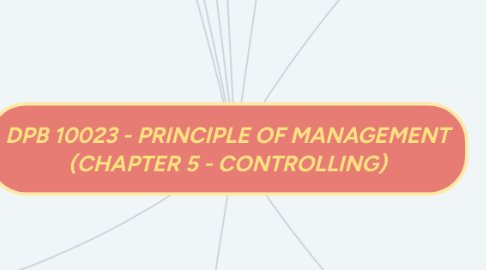
1. Controlling is the process of monitoring actual organizational activities to see that they conform to planned activities and correcting flaws and deviations.
2. 5.1 ) DEFINITION OF CONTROLLING :
3. 5.4) RELATIONSHIP BETWEEN CONTROLLING AND PLANNING :
3.1. Control measures the progress of goal achievement and enables managers to detect the level of quality and weakness in planning so that corrective action can be taken before it is too late.
3.2. Managers must understand the roles of control and planning in order for both functions to work effectively.
4. 5.5) THE CONTROLLING PROCESS :
4.1. 1) A control system is a set of mechanisms to increase the likehood of achieving organizational standards and goals.
4.2. 2) The four steps in the controlling process are :
4.3. - Set the standards
4.4. - Measure the actual performance
4.5. - Compare the actual performance with the standard
4.6. - Take corrective action
5. 5.6) EFFECTIVE CONTROLLING :
5.1. 1) An effective control system will ensure that all activites are performed in accordance with organizational skills.
5.2. 5.6.1 Principles of Effective Controlling
5.3. a) Principle of attainment of objective
5.4. b) Principle of reflection of plans
5.5. c) Principle of control responsibility
5.6. d) Principle of effeciency of controls
5.7. e) Principle of criticial points
5.8. f) Principle of individuality of controls
5.9. g) Principle of review
5.10. h) Principle of action
5.11. 5.6.2 Characteristics of Effective Control
5.12. - Accurate
5.13. - Timely
5.14. - Objective and easy to understand
5.15. - Realistic
5.16. - Focused
5.17. - Flexible
5.18. - Economical
5.19. - Prescriptive
5.20. - Acceptance
5.21. 5.6.3 Finding the Right Degree of Control
5.22. Rigid and Flexible Control Systems
5.23. - Rigid control system
5.24. Employees become rebellious and dissatisfied with their jobs
5.25. - Flexible control system
5.26. Employees perform their tasks half - heartedly and lose interest
5.27. The 'right' degree of control varies from one situation to another. A test laboratory, for instance, may have a more rigid control system than an advertising agency. The economic climate can also affect the degree of control in that people accept tighter controls and restrictions during a recession, while during boom times, rules and restrictions are loosened.
5.28. The task for managers, then, is to find the proper balance between appropriate organizational control and individual freedom.
6. 5.8) CONTROL METHODS
6.1. - Financial Controls
6.2. Financial control refer to the use of financial data to help ensure that organizational goals are being met and specific problems detected before they become seriuos. Financial control methods are widely used because the information required for these techniques be collected, measured and compared easily. Financial controls include : financial statement, audit, budgets, and ratio analysis.
6.3. Traditional Non - financial Controls
6.4. Traditional non - financial control techniques include : statistical data, statistical reports and analysis, internal operation audit and control self - assessment.
6.5. Modern Non - financial Controls
6.6. Modern non - financial control techniques include : Gantt Chart, Milestone Budgeting, Programme Evaluation and Review Technique (PERT), Criticial Path Method (CPM), Balanced Scorecard and Benchmarking.
6.7. The Gantt Chart is easy to build and use but it is only suitable for monitoring simple projects. The Gantt Chart does not show the relationship between activities that must be performed in order to complete a project.
6.8. Milestone Budgeting is used to divide big projects into sub - activities to enable managers to conduct control more easily.
6.9. The criticial Path Method (CPM) is used to assist project managers in scheduling activities (e.g. when each activity should start). It assumes that activity durations are known with certainty.
6.10. The Programme Evaluation and Review Technique (PERT) is used to assist in project scheduling similar to CPM. However, PERT assumes that activity durations are random variables (i.e. probabilistic).
6.11. Balanced Scorecard is a management control system that balances traditional financial measures with operational measures relating to a company's criticial success factors.
6.12. Benchmarking is a continuous process of measuring products, services and practices againts major competitors and industry leaders.
7. 5.2) CONCEPTS OF CONTROLLING :
7.1. Controlling is a continuous managerial exercise that must be undertaken throughout the organization's operational life.
7.2. Managers must emphasize the following two aspects of control in order to ensure a high level of employee performance and the achievement of organizational goals :
7.2.1. a) Output control / Performance control
7.2.2. This control measures the actual performance or results of employees. Output control takes into account three aspects :
7.2.3. 1) Efficiency - managers obtain an overall picture of the employees' level of efficiency.
7.2.4. 2 ) Quality - managers determine whether the actual performance of employees meets the established standards of quality.
7.2.5. 3 ) Feedback - managers obtain feedback from employees to ensure all activities are properly conducted and take corrective action if there are problems.
7.2.6. B) Behaviour Control
7.2.7. This control ensure that employees demonstrate those behaviours that are desired by the organization, e.g. being punctual, creative, alert, hardworking, trustworthy, responsible, keeping company secret, etc.
7.2.8. Managers can use the following techniques in implementing the above controls :
7.2.9. - Budgets : to measure the organization's financial performance
7.2.10. - Quality Control : to monitor employee behaviour
7.2.11. - Self evaluation by managers
7.2.12. - Financial statement
